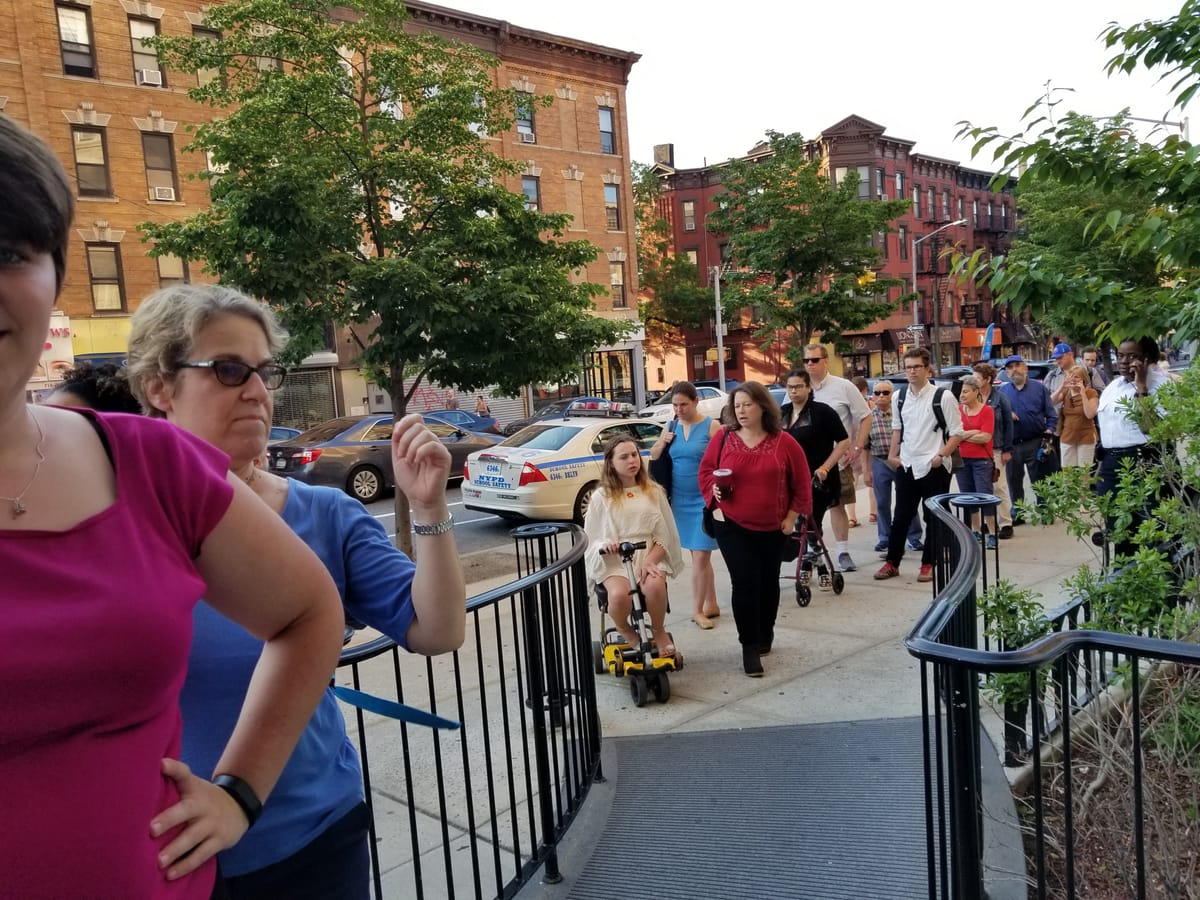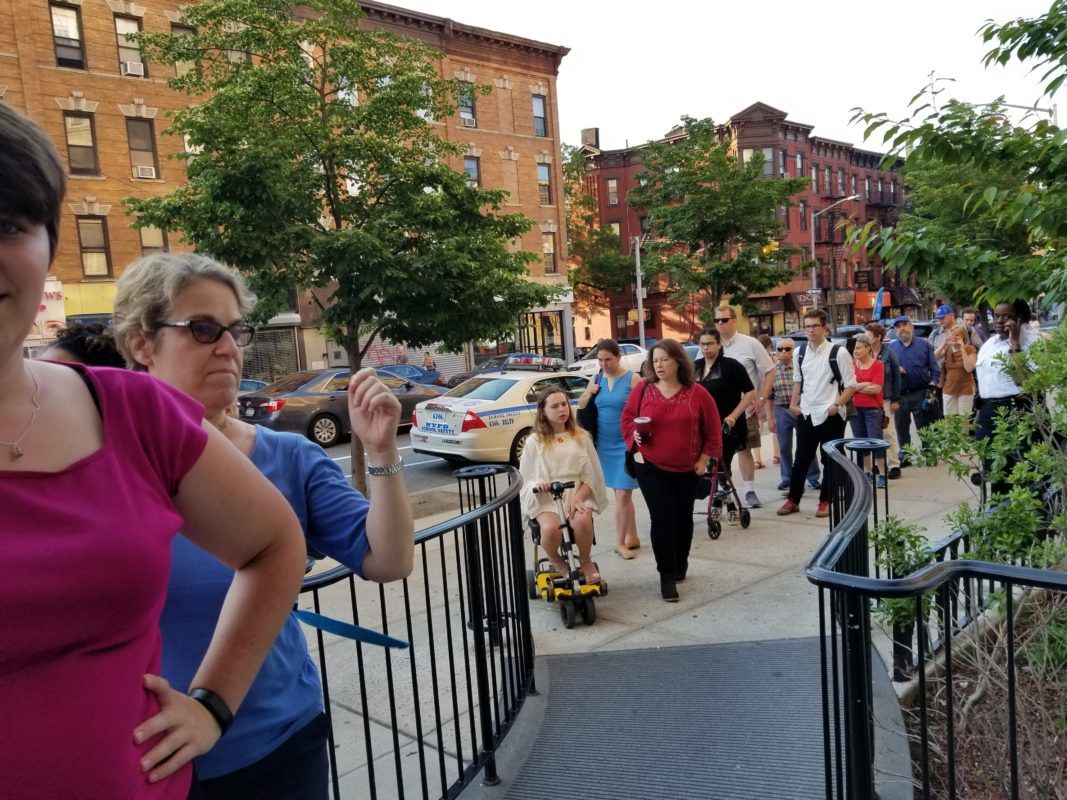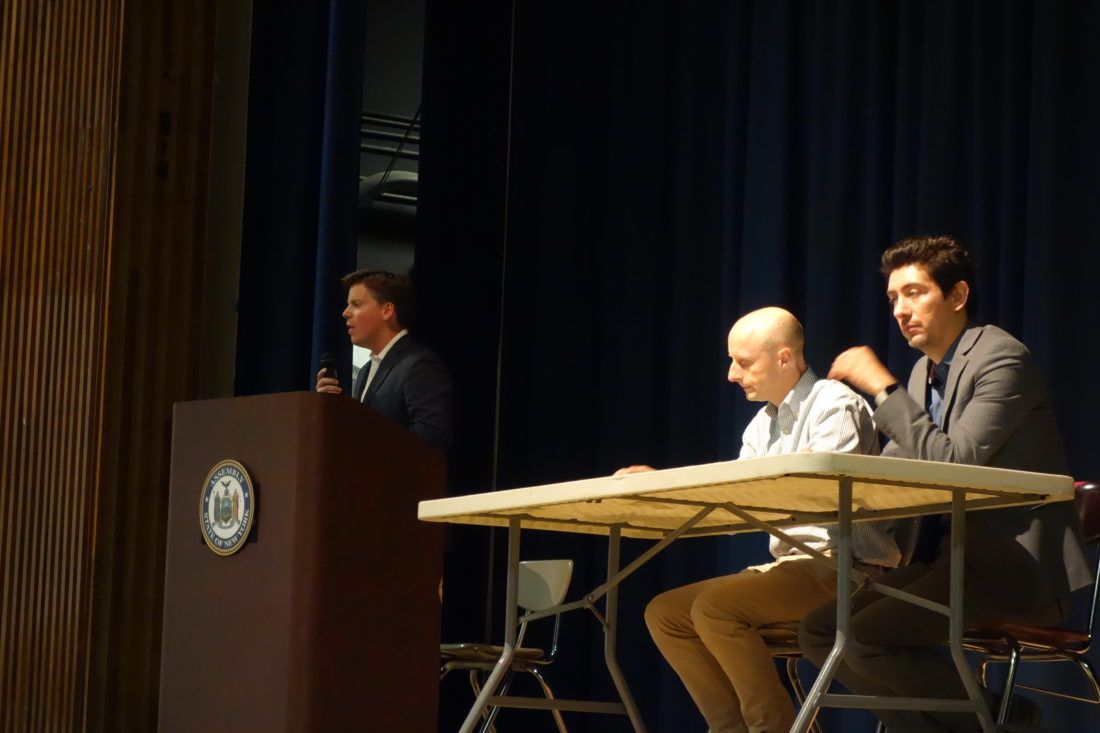People want accessible transit, clear communications and more busses – Town Hall with MTA president Andy Byford


PARK SLOPE – The line was almost down to the corner of 4th street shortly after 6:30 last night as Brooklynites waited to get into the Town Hall meeting with MTA President Andy Byford, organized by their Assembly Member Robert Carroll. Assembly Member Joanne Simon and Council Member Brad Lander were also in attendance.
After brief introductions and a recap of the main points of Fast Forward – the plan to modernize NYC transit (pdf) that Byford has proposed – the floor was opened for questions.
The plan, Byford reminded, has four main components that will be undertaken simultaneously – transform the subway, reimagine busses, make it all accessible to all, and provide world class customer service. Three main themes the plan depends on – customer service and communications, transparency and accountability, and safety and security.
It was the latter themes that kept coming up as resident after resident asked questions, raised issues and offered solutions.

Concerns over accessibility of transit options, including stations, dominated – whether L train stations will be made accessible, will there be an elevator at 18th Avenue F, distances to transit and lack of accessible options south of the Prospect Park were all brought up by the aging and those with disabilities.
Byford said they are bringing on a paid staff position of Accessibility Advocate, who will report to him directly, which was well received. F line repairs should be over by mid-July, with just one station remaining to be completed, though he was not sure about the elevator. Byford also said he will look into the possibility of adding an elevator to the F train station at 7th Avenue, which is blocks away from a major hospital and many schools, despite the station not being on the list of those to receive elevators in the first round of accessibility improvements. All said, in 5 years there should be no more than 2 stops between accessible stations.
Brighton Beach resident Lolita Divilova asked about potential for noise mitigation for F train around West 8th street. Trains making the curve screech and the noise is so bad residents can’t sleep, and Byford said they will look into it. She also brought up issues of station design that allow kids to throw objects on those below damaging property. This was the first question where Byford was puzzled by the culture of the city where that kind of behavior would be acceptable.
It came up again when issues of vandalism and lack of public toilets were brought up as well as when requests were made for more garbage cans.

Meeting took place in Park Slope, so B71 was topic of so many questions that Assemblyman Carroll had to ask neighbors to resist asking the question for the sake of asking it, allowing other questions to be heard. B71 used to connect Redhook to Park Slope, Crown Heights and Gowanus and was discontinued in 2010. Residents and Council Member lander are advocating to bring it back.
Byford said that his plan will include a complete redesign of every one of the 370 routes in the city over the next 3-5 years, with the exception of Select bus Routes, which seem to be popular and working well.
Park Slope NORC (naturally occurring retirement community) member was first but not last to bring up signage and communications issues. In particular, a request was made to add priority seating for elderly so it would be easier for them to ask for a seat on busses and subway.
A neighbor from Sunset Park recounted how during the blackout at 36th street and 4th Avenue station at the end of last summer she stood and translated for close to an hour for her neighbors because the MTA directions were incomprehensible and not available in languages other than English. Others said that no-one can understand the service change and reroute information.
Byford promised to look into it, and said that as stations move to smart card technology over the next few years, agents will be equipped with ipads and expected to move around the station helping commuters. That could include translation apps.
MTA is also planning a large scale sensitivity training for all employees, which will also include section on how to communicate clearly, in plain English. Currently in 150 stations MTA cannot even make direct public announcements, the plan is to change that.

In addition to B71, Fred from Ditmas Park flagged issues with B68, which after 9pm runs every half hour, and often results in close to an hour wait for users along Coney Island Avenue. He also brought up the issues along Cortelyou Road, which is where the Brooklyn-Manhattan express busses all get jammed up, suggesting that parking regulations may need to be looked at. Another resident said that enforcing no-parking in bus lanes regulations did not seem to be a high priority issue with the NYPD. Automated enforcement through cameras on busses may solve that, but legislation necessary.
A shift worker spoke on behalf of those like her who are constantly rattled by the off peak schedules that wreak havoc on trying to get to and from work on daily basis. Would a reduced fare for off peak use be possible? Byford suggested that smart cards would certainly allow for an easy implementation of such a plan, and that they do not object in principle, but it involves funding and that is out of his hands.
Asked if this is the worst or if it will get worse before getting better, Byford only offered that there is a lot that can be done straight away to make transit a better experience for all that does not require additional resources, and that we should start seeing positive changes right away.
While the city council members can advocate for change, MTA is really under the purview of the New York State, so if you have strong opinions, suggestions and requests, do sound off to the MTA but also make sure you let your NYS Senator and Assembly member know, for they are the ones in position to fund and regulate the authority.



